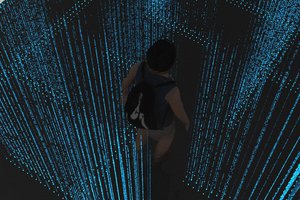The LASER Pointer Light Show uses 3 different motors each of which spins a mirror. Each mirror is mounted slightly off of 90 degrees causing the LASER beam to project a circular pattern. The spiral pattern is a combination of the 3 circular patterns running at different speeds. The usual analogy for those old enough to remember is the Spirograph toy invented by Denys Fisher.
Each mirror is mounted approx 90 degrees from the previous mirror, creating a 'U' shaped pattern. The light also travels a 'U' shape of 270 degrees total (45 degrees off of the mirror's angle). The motors are cheap 6V ~12000RPM hobby motors I found online. The speed of the motors is controlled by 100 Ohm, 2W pots. (50 Ohm pots would be better but are harder to find.) Power is provided via 4 AAA batteries.
It would be easy to include the LASER in the box if you wanted to. The one I built just has a hole in the side where you shine a LASER pointer in and another hole where the pattern emerges.
 Alpha Charlie
Alpha Charlie






 TokyLabs
TokyLabs
 Russell Grokett
Russell Grokett
 Hexastorm
Hexastorm